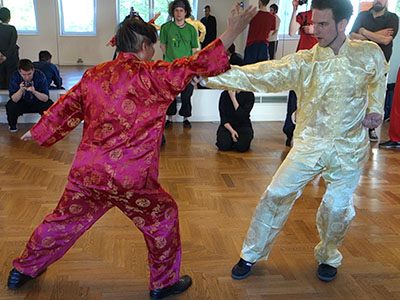The Animal Forms in different
Kung Fu Styles and Sets
The Five Animals of Shaolin Kung Fu
Part 2

Snake meets tiger in the
Shaolin Five-Animal Combination Set
In the course of centuries, due to the personal preferences and characters of the respective masters, different sets, i.e. sequences of many techniques, were developed, manifesting different characteristics. This has resulted in numerous Kung Fu styles. While many sets emphasize individual qualities and emphases represented by the certain animal forms, Shaolin Kung Fu – with a few exceptions – rarely deals exclusively with one animal style only.
Therefore, in sets emphasizing the dragon one will also find a crane kick here or a tiger technique there. This is also a good outward representation that Shaolin Kung Fu is a comprehensive and holistic system, not limited to individual components. This makes Shaolin Kung Fu the perfect foundation, which makes it easy to pick up another Kung Fu style. Many styles developed later focus more on individual aspects.
Here is a brief overview of the influence of the five animals on different styles and sets.
The Five-Animal Set
While "Lohan Kung Fu" (Lohanquan) is the prototype and also the characteristic set for Northern Shaolin Kung Fu, the "Shaolin Five-Animal Set" is a characteristic set for its further development, that is Southern Shaolin Kung Fu. It combines all five animal styles in a sequence and is therefore the most efficient set to benefit from the holistic training of all of the animal spirits.
The widespread Hoong Ka Kung Fu (also Hung Gar; Hung Kuen; Hung Kyun), the style of Lam Sai Wing and Wong Fei Hoong, is one of the continuations of Southern Shaolin Kung Fu and contains, for example, a "Five-Animal Set", as well as another Southern Shaolin style, Choy-Li-Fatt Kung Fu.
The Five-Animal Set in Shaolin Wahnam was compiled by our Grandmaster, based on Kung Fu classics and his own experience, for his book "The Art of Shaolin Kung Fu". It is ideal to get a good insight into all the five classic animal spirits and to train them. The corresponding combination set (partner set) conveys many profound combat applications and principles.
Choose video here:
Tiger & Crane
In addition to the tiger-spirit sets "Taming the Tiger" and "Iron Wire", Hoong Ka is particularly known for its "Tiger-Crane Set". These two animal spirits are, besides the dragon, the dominant animals of the style. Contrary to the common presumption of Hoong Ka Kung Fu being an external style, it should contain a distinctive internal component and be based on internal force (tiger).
In addition to the 108-pattern version from Hoong Ka and the 72-pattern version of the legendary Ng Mui, the 36-pattern set after grandmaster Lai Chin Wah, favoured by many, is also contained in the repertoire of Shaolin Wahnam. The short version with 36 techniques can be considered as the crystallized essence and even has more specific tiger and crane techniques than the 108-pattern set, which is based on Lohan Kung Fu.
Choose video here:
Snake & Crane
Legend has it that the great Zhang San Feng observed the fight between a crane and a snake. This inspired him to make his Kung Fu even more fluid and elegant. Many consider his martial art as the origin of Tai Chi Chuan. In Wahnam Tai Chi Chuan, besides the crane and the snake, the dragon plays a major role. Classical records suggest that the dragon was dominant in Zhang San Feng's Kung Fu too.
The Shaolin Flower Set also makes use of the snake and the crane. Therefore, it is obvious that the resulting Wing Choon Kung Fu also predominantly uses these animals.
It is interesting to note that Tai Chi Chuan and Wing Choon have the focus on the same two animals that are considered the softest of the five, and both styles are known to be particularly well suited for overcoming stronger opponents. Nevertheless, the two martial arts differ very clearly in appearance, approach and philosophy.
The crane gives Wing Choon its directness and economic movement. Many arm movements resemble the flapping of crane wings. In Tai Chi Chuan the crane expresses itself through elegance and balance. The snake makes the movements of the Tai Chi Chuan circular, round and flowing and stimulates energy flow, while in Wing Choon it is manifested by the "shoot" (sudden palm thrusts). In general, Tai Chi Chuan is more influenced by the snake spirit, to which it owes the development of internal force. Wing Choon is more dominantly characterized by the crane and its avoidance of useless movements.
Choose video here:
Dragon
One of the specialties of our grandmaster is the rare "Dragon Strength Chi Circulation Set". It is ideal for training the dragon spirit, Dragon Force, Dragon Speed and Dim Mak. That is why it is one of our greatest treasures and why it is also the favourite set of my Sifu and myself.
Our "Shaolin Dragon Form Set" originates from Northern Shaolin Kung Fu. Our grandmaster once "exchanged" it with one of his Sihengs against the Tiger-Crane Set. It contains the extraordinary pattern "Dragon Manifests Miraculous Majesty", which was very important for Sifu’s development of the Dragon Force.
As the name suggests, the "Shaolin Travelling Dragon Pakua Set" has a high proportion of dragon forms and is very beneficial to the training of the dragon spirit.
Choose video here:
Dragon & Tiger
Two of the most popular animal styles, the dragon and the tiger, are united in Sifu’s "Dragon-Tiger Set". Originally, he developed the set using corresponding techniques he knew for one of his students. Sifu later used it as a basis for his profound book "Introduction to Shaolin Kung Fu".
The "Triple Stretch Set", which Sifu has compiled from two different "Great Majestic Sets", is dominantly influenced by the dragon and the tiger. It develops a lot of consolidated internal force, but at the same time, it can also be very flowing.
Choose video here:
Leopard
In Shaolin Wahnam, the leopard does not have any pronounced significance, since our training is not oriented towards the development of muscular strength, but rather cultivates internal force. Other martial arts basing on Western fitness training, such as boxing, would be attributed to the leopard according to Kung Fu philosophy.
Unfortunately, most Kung Fu styles are trained externally too nowadays. Regardless of whether the associated schools use tiger forms and those of other animals and talk about the philosophy of the five animals, as long as the training remains on a purely physical level, the leopard is the dominant animal characteristic.
Regarding the other quality of the spotted cat of prey, namely speed, the highest goal in Shaolin Wahnam is "Dragon Speed", which is superior. "Dragon Speed" uses the mind and energy flow instead of locally built muscular strength. Nevertheless, leopard techniques give us a tactical hint, as they remind us in our combat sequences to act quickly.
Choy-Li-Fatt Kung Fu, which was developed for fighting on the battlefield, emphasizes the leopard by using muscular strength and speed. Genuine masters of the style also have internal force, which makes the tiger the dominant animal spirit.
Other Correlations
Well-known styles whose dominant animal spirits were name-giving, are for example, Pak Mei's "Dragon Kung Fu", "Black Tiger Kung Fu" and "White Crane Kung Fu" from Fujian.
In Wuzuquan, also practiced in Shaolin Wahnam, the crane is dominant.
One of the three most famous internal martial arts styles, next to Taijiquan and Xingyiquan (more on this in the next article of this series) is Baguazhang. In the style known especially for agility, the dragon plays an important role. One of our sets is also called "Baguazhang Swimming Dragon Set".




